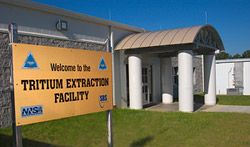
Nuclear Regulatory Commission Paves Way for Increase in Production of Tritium for Nuclear Weapons, Further Undermining Nuclear Non-Proliferation Norms and Keeping U.S. on Nuclear War Footing
SRS Watch news, February 23, 2024: SRS Watch news tritium production by TVA Feb 23 2024
NRC’s Federal Register notice of February 24, 2024:
https://www.govinfo.gov/content/pkg/FR-2024-02-23/pdf/2024-03665.pdf
Columbia, South Carolina – The U.S. Nuclear Regulatory Commission has taken a big step forward in allowing expansion of production of tritium, a radioactive gas used to boost the explosive power of all U.S. nuclear weapons. Increased tritium production would take place in the Tennessee Valley Authority’s Watts Bar nuclear power reactors, further undermining nuclear nonproliferation norms by allowing continued production of nuclear weapons materials in commercial nuclear power reactors.
The NRC published a notice on February 23, 2024 that supports the decision to dramatically increase the production of tritium in the Watts Bar units 1 and 2 reactors in Tennessee. The NRC, a civilian regulatory agency, recommends that the licenses for both reactors be amended to allow for an increase in irradiation of special tritium-producing rods from 1,792 to 2,496 for each reactor in a single operating cycle of about 18 months.
The significant increase in irradiation of Tritium Producing Burnable Absorber Roads (TPBARs) in the reactors’ cores would result in production of much greater amounts of tritium, as requested by the U.S. Department of Energy’s National Nuclear Security Administration (NNSA) for its client (Department of Defense). According to NNSA’s 2023 “Stockpile Stewardship and Management Plan,” the “goal to reach maximum tritium production in each of the two Watts Bar reactors by FY 2025.”
“Expansion of tritium production for use in all nuclear warheads reveals that the U.S. aims to keep a massive nuclear weapons stockpile far beyond any level of deterrence,” said Tom Clements, director the public interest group Savannah River Site Watch, based in Columbia South Carolina. “For the sake of global security, the U.S. must adopt a policy to reduce and eliminate nuclear weapons, thus in parallel reducing and eliminating the need to produce weapons tritium in civilian nuclear reactors,” added Clements.
The apparent objective with this larger tritium supply is for the NNSA to fill the tritium “reservoirs” in all warheads to maximum capacity, which could be up to around 5 grams of tritium per warhead. This would allow the weapons to operate with greater flexibility, including
at their highest explosive yield, thus keeping the U.S. on a footing to “fight” a nuclear war with maximum destructive effect. Other nuclear weapons countries will take note of this decision.
The NRC has documented in an “environmental assessment” (EA) that radiation exposure, tritium release into the environment and nuclear waste production would all increase due to the action but has declined preparation of a more in-depth “environmental impact statement.” The NRC claims the impacts are within earlier-considered bounds and has thus issued a “Finding of No Significant Impact” (FONSI) and recommends that a license amendment be issued by the NRC to allow more tritium rods to be irradiated.
(Note: The NRC has informed SRS Watch that URLs for the EA and FONSI may not be available until February26, 2024. According to SRS Watch, they should have been available at the time of the posting of the Federal Register notice around 6:00 a.m. on February 23.)
TVA submitted a license amendment request (LAR) on March 20, 2023 requesting that the NRC allow the increase in TPBAR irradiation. The request was accepted by the NRC on April 21, 2023. NRC has informed Savannah River Site Watch that their review of the LAR should be finished by April 21, 2024.
In a February 22, 2023 presentation to the NRC, TVA stated that the proposed license-amendment review schedule “supports a planned increase of TPBAR inventory in the WBN Unit 1 Cycle 19 refueling outage (U1R19) in fall 2024 and WBN Unit 2 U2R6 in spring 2025 to support DOE requests.” The uranium in the fuel used in the reactors is required to be of domestic origin, or “unobligated” of any restrictions that a foreign supplier might place on such use for military-related purposes. In a 2015 document (“Tritium and Enriched Uranium Management Plan Through 2060”) NNSA identified ways to extend the unobligated low-enriched uranium fuel supply to around 2040. In 2014, the Government Accountability Office recommended review of the policy to use only unobligated uranium for tritium production.
On September 14, 2023, NNSA issued a decision that it will not expand tritium production to TVA’s Sequoyah reactors located near Chattanooga, Tennessee and that it will only use the Watts Bar reactors for the military mission. TVA is owned by the federal government and thus compliant in doing the nuclear weapons work, which is far outside its energy-production mission.
Highly radioactive TPBARs removed from the reactors would be transported to DOE’s Savannah River Site (SRS) near Aiken, South Carolina for processing in tritium facilities that are now being expanded. At SRS, tritium “reservoirs” would be filled and shipped to other sites for loading into nuclear warheads. The processed TPBARs, not classified as high-level nuclear waste, would be placed into concrete bunkers on the surface in E-Area, where they have been observed to leak tritium into the environment. DOE is an independent agency not regulated by the NRC.
Due to increased tritium production, TPBAR manufacture at the Westinghouse uranium fuel plant near Columbia, SC would also expand. Production in a commercial nuclear facility of TPBARs used to produce tritium for military use exposes the reality that the Westinghouse facility is a dual use military-commercial facility, thus crossing the imaginary line between civilian and military uses of nuclear technology (as documented by SRS Watch).
###
DOE photos: Tritium Extraction Facility at the Savannah River Site; tritium reservoir that’s inserted into a nuclear warhead (no scale provided)
Update of Feb. 27, 2024: News release posted via EINPresswire: https://www.einpresswire.com/article-print/691542118/nuclear-regulatory-commission-paves-way-for-increase-in-production-in-commercial-reactors-of-tritium-for-nuclear-weapons